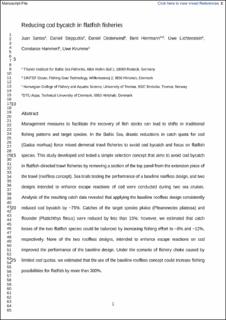| dc.contributor.author | Santos, Juan | |
| dc.contributor.author | Stepputtis, Daniel | |
| dc.contributor.author | Oesterwind, Daniel | |
| dc.contributor.author | Herrmann, Bent | |
| dc.contributor.author | Lichtenstein, Uwe | |
| dc.contributor.author | Hammerl, Constanze | |
| dc.contributor.author | Krumme, Uwe | |
| dc.date.accessioned | 2023-03-03T14:53:33Z | |
| dc.date.available | 2023-03-03T14:53:33Z | |
| dc.date.created | 2022-03-14T12:52:58Z | |
| dc.date.issued | 2022 | |
| dc.identifier.citation | Ocean and Coastal Management. 2022, 220, 1-14. | en_US |
| dc.identifier.issn | 0964-5691 | |
| dc.identifier.uri | https://hdl.handle.net/11250/3055817 | |
| dc.description.abstract | Management measures to facilitate the recovery of fish stocks can lead to shifts in traditional fishing patterns and target species. In the Baltic Sea, drastic reductions in catch quota for cod (Gadus morhua) force mixed demersal trawl fisheries to avoid cod bycatch and focus on flatfish species. This study developed and tested a simple selection concept that aims to avoid cod bycatch in flatfish-directed trawl fisheries by removing a section of the top panel from the extension piece of the trawl (roofless concept). Sea trials testing the performance of a baseline roofless design, and two designs intended to enhance escape reactions of cod were conducted during two sea cruises. Analysis of the resulting catch data revealed that applying the baseline roofless design consistently reduced cod bycatch by ∼75%. Catches of the target species plaice (Pleuronectes platessa) and flounder (Platichthys flesus) were reduced by less than 15%; however, we estimated that catch losses of the two flatfish species could be balanced by increasing fishing effort to ∼8% and ∼12%, respectively. None of the two roofless designs, intended to enhance escape reactions on cod, improved the performance of the baseline design. Under the scenario of fishery choke caused by limited cod quotas, we estimated that the use of the baseline roofless concept could increase fishing possibilities for flatfish by more than 300%. | en_US |
| dc.language.iso | eng | en_US |
| dc.publisher | Elsevier | en_US |
| dc.rights | Attribution-NonCommercial-NoDerivatives 4.0 Internasjonal | * |
| dc.rights.uri | http://creativecommons.org/licenses/by-nc-nd/4.0/deed.no | * |
| dc.subject | Fish behaviour | en_US |
| dc.subject | Dual-species indicators | en_US |
| dc.subject | Fishing effort | en_US |
| dc.subject | Catch comparison | en_US |
| dc.subject | Landing obligation | en_US |
| dc.subject | Roofless device | en_US |
| dc.subject | Bycatch reduction | en_US |
| dc.title | Reducing cod bycatch in flatfish fisheries | en_US |
| dc.title.alternative | Reducing cod bycatch in flatfish fisheries | en_US |
| dc.type | Peer reviewed | en_US |
| dc.type | Journal article | en_US |
| dc.description.version | acceptedVersion | en_US |
| dc.rights.holder | This is the authors’ accepted and refereed manuscript to the article. This manuscript version is made available under the CC-BY-NC-ND 4.0 license Open access from 12 February 2024. | en_US |
| dc.source.pagenumber | 14 | en_US |
| dc.source.volume | 220 | en_US |
| dc.source.journal | Ocean and Coastal Management | en_US |
| dc.identifier.doi | 10.1016/j.ocecoaman.2022.106058 | |
| dc.identifier.cristin | 2009518 | |
| dc.source.articlenumber | 106058 | en_US |
| cristin.ispublished | true | |
| cristin.fulltext | postprint | |
| cristin.qualitycode | 1 | |

